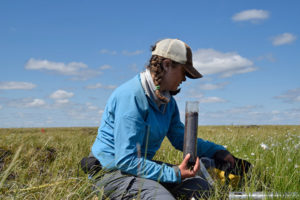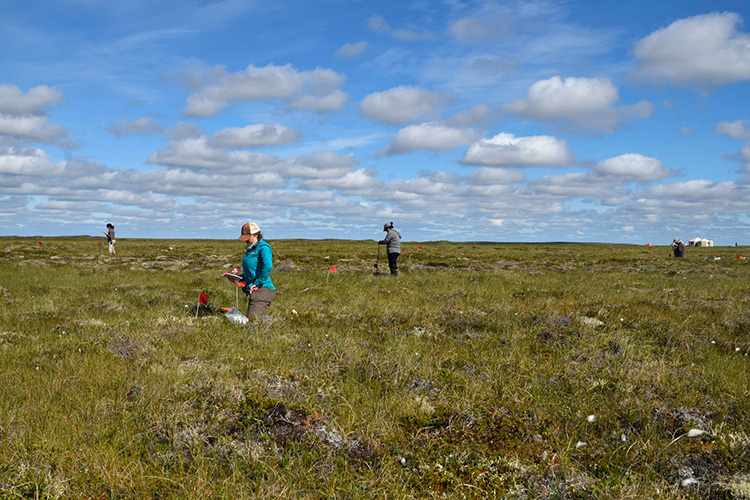The 2017 Polaris Project team spent two weeks studying climate change impact on the tundra of Alaska’s Yukon-Kusksokwim Delta. The team – including students and scientist faculty – returned to the Woods Hole Research Center on July 15 to process the samples they had taken in the field.
By Sierra Melton
 As I rode in the backseat of a bright yellow floatplane over the Yukon-Kuskokwim Delta, I could not look away from the mesmerizing landscape below. Greens mixed with yellows and browns in swirling fractal patterns. Shimmering streams wove their way between the colors, sometimes connecting lakes. Every so often, we would fly over a patch of land that clearly held the memory of a lake but was now dry like the surrounding green patches. I watched the endless patchwork of patterns and textures below as the plane hurried on, certain that I would never tire of this view.
As I rode in the backseat of a bright yellow floatplane over the Yukon-Kuskokwim Delta, I could not look away from the mesmerizing landscape below. Greens mixed with yellows and browns in swirling fractal patterns. Shimmering streams wove their way between the colors, sometimes connecting lakes. Every so often, we would fly over a patch of land that clearly held the memory of a lake but was now dry like the surrounding green patches. I watched the endless patchwork of patterns and textures below as the plane hurried on, certain that I would never tire of this view.
I was on my way to The Polaris Project’s field camp in the Yukon Delta National Wildlife Refuge, where scientists, students, camp managers, doctors, and a filmmaker were waiting to welcome me and the other students to what would become our home away from home. As we approached, the impressive camp came into focus. Perched along a peninsula jutting into “Landing Lake” were three large yurt-like tents, two outhouse tents, and an array of colorful sleeping tents, which would later come to be known as “tent city.”
I climbed out of the plane, sloshed into the shallow water in my trusty rubber boots, and climbed up the steep bank of the lake as an intense feeling of gratitude and disbelief overcame me. This was a dream come true: Two weeks in a remote field camp dedicated to working with respected research scientists on issues related to arctic climate change. I could not wait to get started.
The best aspect of The Polaris Project is the lead scientists’ dedication to student research. Every student was encouraged to develop our own research question based upon curiosities arising from studying and experiencing this Alaskan tundra ecosystem firsthand. The scientists urged us to think critically for ourselves and were always there to help us reason through whatever uncertainties may arise. Although this was my favorite part of the project, it was also the most intellectually taxing. With limited previous knowledge about the uniqueness of the Yukon-Kuskokwim Delta and the intertwined chemical/biological/physical processes at hand, it was difficult to address a pressing question concerning permafrost thaw and the changes in the delta with an original scientific investigation. Curious about the variability of the landscape and its potential to release carbon into the atmosphere as air temperatures increase, I ultimately chose to explore the reasons for variability in carbon emissions across the landscape and the ways in which soil moisture governs carbon processing.
The next two weeks flew by as I visited sites to collect soil and soil gas samples. I was excited by my ability to quickly learn the species names of a handful of tundra plants in order to characterize the vegetation at each site. As a geology student, I had never before dedicated as much focus to the plant communities in my research locations. I also discovered a fen (a strip of shallow, unchannelized flowing water) in an area that had recently experienced a wildfire, and in which the surface water was covered with a hydrocarbon film. This fen (I would later discover in the lab) was emitting crazy scary amounts of methane – a potent greenhouse gas.
Interspersed with my own research activities were countless other adventures, such as flying in the dragonfly-like helicopter with Stan the Man to field sites out of walking distance, eating cloudberries, fresh-baked cookies (thanks to Robin, the fantastic camp cook) and soil (don’t worry – not in Robin’s cooking), hiding in the common tent from a grizzly and a rain/wind storm, watching a fox snatch a duck right next to camp, pushing a raft full of field equipment across Landing Lake to drill permafrost cores, discovering soil with trampoline-like properties, and singing Britney Spears while Kevin (the awesome camp manager) played guitar in an inflatable T-rex suit.
Needless to say, I was sad to leave the Polaris camp. As I flew back to the town of Bethel on the floatplane, the awe-inspiring tundra landscape below again captured my eye and my imagination. This time, however, I was struck not only by the beauty of the place, but also by the research questions it evoked. I looked down on peat plateaus, fens, ponds, lakes, drained lakes, and streams, a place that was characterized by infinite interconnected scales of differences and similarities. I wondered about the patterns of drainage and ground subsidence accompanying permafrost thaw, whether this could be investigated from a different perspective with the help of geophysical methods, and the impacts of fire on lake drainage and stream geomorphology.
Now, after a couple weeks of lab work, data analysis, and synthesis at the Woods Hole Research Center, I find myself with even more questions. How does the mineral-rich soil in burned landscapes respond to changes in soil moisture differently than does the organic-rich soil in unburned landscapes, and how does this impact carbon emissions? How does this difference in soil affect water flow and nutrient transport? Since fire frequency in the tundra is projected to increase with climate change, the answers to these questions could shed light on critical processes governing the future of permafrost environments. I am more inspired than ever to continue searching for answers while expanding my knowledge across scientific disciplines, because I never know what other questions I may uncover along the way and what expertise may be needed to answer them.
Sierra Melton is a rising senior at Colorado College. She expects to graduate in 2018 with a B.A. in geology.




